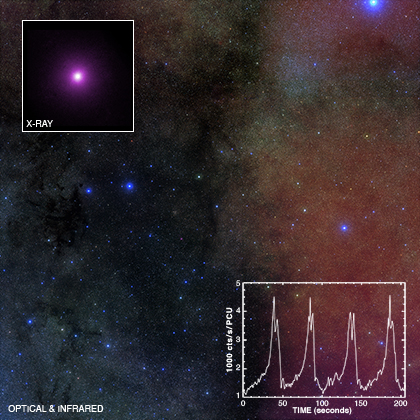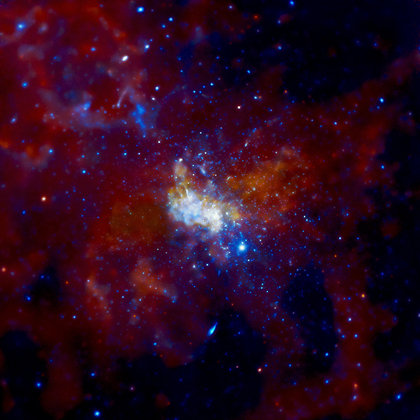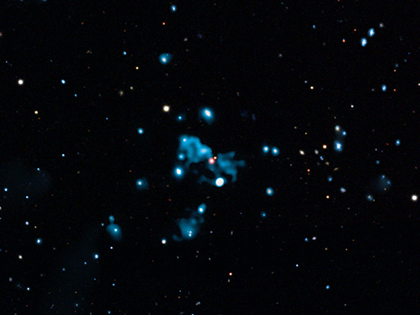Submitted by chandra on Tue, 2011-01-11 11:12

This optical and infrared image from the Digitized Sky Survey shows the crowded field around the binary system GRS 1915+105 (GRS 1915 for short) located near the plane of our Galaxy. The top-left inset shows a close-up of the Chandra image of GRS 1915 , and the bottom-right inset shows the remarkable "heartbeats" seen in the X-ray light from this system. Using Chandra and the Rossi X-ray Timing Explorer (RXTE), astronomers have discovered what drives these heartbeats and given new insight into the ways that black holes can regulate their intake and severely curtail their growth.
Submitted by chandra on Wed, 2010-07-21 14:44

4C+00.58 is a galaxy harboring a giant black hole about 780 million light years away.
Submitted by chandra on Wed, 2010-07-07 15:29
Submitted by chandra on Tue, 2010-01-05 09:45

Astronomers have long known that the supermassive black hole at the center of the Milky Way Galaxy, known as Sagittarius A* (or Sgr A* for short), is a particularly poor eater. The fuel for this black hole comes from powerful winds blown off dozens of massive young stars that are concentrated nearby. These stars are located a relatively large distance away from Sgr A*, where the gravity of the black hole is weak, and so their high-velocity winds are difficult for the black hole to capture and swallow. Scientists have previously calculated that Sgr A* should consume only about 1% of the fuel carried in the winds.
Submitted by chandra on Tue, 2009-10-06 12:02
Submitted by chandra on Tue, 2009-09-01 11:44
Last week, we released the Chandra image of an object known as Cygnus X-1. At first glance, Cygnus X-1 might not look that important – even with Chandra’s excellent X-ray vision – but this is one case where it’s good not to judge a book by its cover.

Submitted by chandra on Thu, 2009-05-28 14:25
This is a composite image showing a small region of the Chandra Deep Field North. Shown in blue is a deep image from the Chandra X-ray Observatory and in red is an image from the Multi-Element Radio Linked Interferometer Network (MERLIN) an array of radio telescopes based in Great Britain. An optical image from the Sloan Digital Sky Survey (SDSS) is shown in white, yellow and orange.

Submitted by chandra on Wed, 2009-03-25 14:20
This optical and infrared image from the Digitized Sky Survey shows the crowded field around the micro-quasar GRS 1915+105 (GRS 1915 for short) located near the plane of our Galaxy. The inset shows a close-up of the Chandra image of GRS 1915, one of the brightest X-ray sources in the Milky Way galaxy. This micro-quasar contains a black hole about 14 times the mass of the Sun that is feeding off material from a nearby companion star. As the material swirls toward the black hole, an accretion disk forms.
Pages